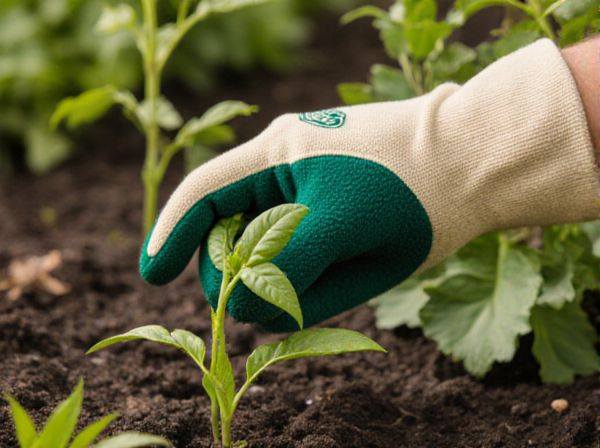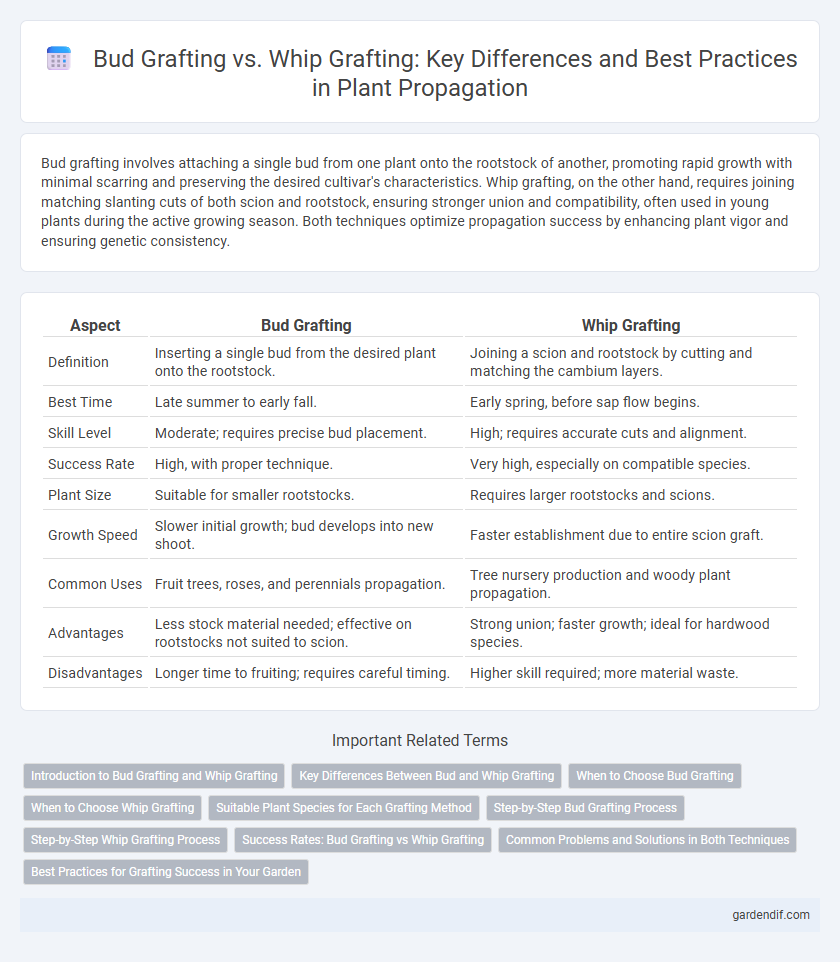
Bud Grafting vs Whip Grafting Illustration
Bud grafting involves attaching a single bud from one plant onto the rootstock of another, promoting rapid growth with minimal scarring and preserving the desired cultivar's characteristics. Whip grafting, on the other hand, requires joining matching slanting cuts of both scion and rootstock, ensuring stronger union and compatibility, often used in young plants during the active growing season. Both techniques optimize propagation success by enhancing plant vigor and ensuring genetic consistency.
Table of Comparison
| Aspect | Bud Grafting | Whip Grafting |
|---|---|---|
| Definition | Inserting a single bud from the desired plant onto the rootstock. | Joining a scion and rootstock by cutting and matching the cambium layers. |
| Best Time | Late summer to early fall. | Early spring, before sap flow begins. |
| Skill Level | Moderate; requires precise bud placement. | High; requires accurate cuts and alignment. |
| Success Rate | High, with proper technique. | Very high, especially on compatible species. |
| Plant Size | Suitable for smaller rootstocks. | Requires larger rootstocks and scions. |
| Growth Speed | Slower initial growth; bud develops into new shoot. | Faster establishment due to entire scion graft. |
| Common Uses | Fruit trees, roses, and perennials propagation. | Tree nursery production and woody plant propagation. |
| Advantages | Less stock material needed; effective on rootstocks not suited to scion. | Strong union; faster growth; ideal for hardwood species. |
| Disadvantages | Longer time to fruiting; requires careful timing. | Higher skill required; more material waste. |
Introduction to Bud Grafting and Whip Grafting
Bud grafting involves joining a single bud from a desired plant onto the rootstock, promoting efficient propagation with minimal scion wood. Whip grafting unites a young shoot or scion with the rootstock through matching angled cuts, allowing rapid healing and strong union. Both methods enable vegetative propagation but differ in complexity, timing, and plant tissue used.
Key Differences Between Bud and Whip Grafting
Bud grafting involves attaching a single bud from a donor plant onto the rootstock, while whip grafting joins entire stems or scions with matching cambium layers. Bud grafting is preferred for quicker union and less scion material, whereas whip grafting provides stronger structural support for larger plant parts. The choice depends on plant species, desired growth speed, and propagation goals.
When to Choose Bud Grafting
Bud grafting is ideal when working with limited scion wood and aiming for higher success rates in dormant or early growing seasons. It excels in fruit tree propagation, especially for species like apples and roses, where precise compatibility and minimal scion material are crucial. Choose bud grafting when rapid healing and less labor-intensive techniques are preferred, particularly in warmer climates.
When to Choose Whip Grafting
Whip grafting is ideal during early spring when both scion and rootstock are dormant but starting to show signs of growth, ensuring optimal cambium contact for successful union. This method is preferred for young, similarly sized plant materials, particularly in fruit trees like apples and pears, where a smooth, continuous cut allows better nutrient flow. Choosing whip grafting over bud grafting improves compatibility and strength in early-season propagation efforts.
Suitable Plant Species for Each Grafting Method
Bud grafting suits fruit trees like apples, pears, and cherries, allowing single bud insertion onto rootstock for precise variety propagation. Whip grafting is ideal for young deciduous trees such as walnuts, chestnuts, and apples, involving the joining of scion and rootstock with matching cuts for fast vascular connection. Each method enhances compatibility and growth efficiency depending on plant species and developmental stage.
Step-by-Step Bud Grafting Process
Bud grafting involves carefully selecting a healthy bud from the scion and creating a T-shaped cut on the rootstock, ensuring precise alignment for optimal cambium contact. The bud is then gently inserted under the bark flap and tightly secured with grafting tape or rubber bands to prevent moisture loss and promote successful union. This step-by-step process enhances the chances of successful propagation by allowing the graft to heal and grow into a new shoot.
Step-by-Step Whip Grafting Process
The whip grafting process begins by selecting healthy rootstock and scion wood of similar diameter, both cut at matching slanting angles to maximize cambium contact. Next, the rootstock and scion are carefully joined, ensuring the cambium layers align perfectly to facilitate nutrient flow and successful union. Finally, the graft union is tightly wrapped with grafting tape or wax to prevent moisture loss and protect against infection, promoting optimal healing and growth.
Success Rates: Bud Grafting vs Whip Grafting
Bud grafting demonstrates higher success rates in warmer climates due to its ability to establish vascular connections quickly, typically achieving 70-90% success under optimal conditions. Whip grafting, preferred in early spring when both scion and rootstock are dormant, often shows success rates ranging from 60-80%, benefiting from the large cambium contact area. The choice between bud and whip grafting success heavily depends on environmental factors and timing, influencing the graft union's survival and growth vigor.
Common Problems and Solutions in Both Techniques
Bud grafting and whip grafting often encounter issues like poor union formation, incompatible scions, and desiccation due to improper alignment or timing. Solutions include selecting compatible rootstocks and scions, ensuring tight contact between cambial layers, and maintaining high humidity during the healing process. Proper sanitation and using grafting wax or tape also help prevent infections and improve success rates in both techniques.
Best Practices for Grafting Success in Your Garden
Bud grafting requires precise timing, typically performed during the early growing season when buds are dormant, ensuring better callus formation and successful union. Whip grafting demands sharp, compatible cuts on both rootstock and scion, with tight alignment of cambium layers to maximize nutrient flow and promote healing. Using sanitized tools, maintaining adequate moisture, and protecting grafts with grafting tape or wax are essential best practices to enhance grafting success in your garden.
Bud Grafting vs Whip Grafting Infographic

 gardendif.com
gardendif.com